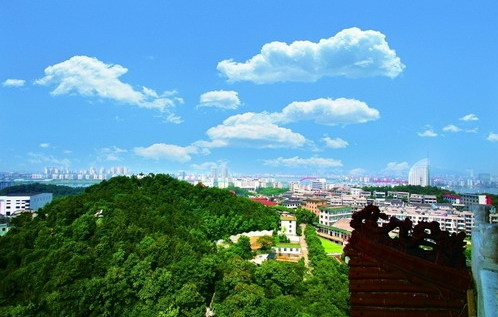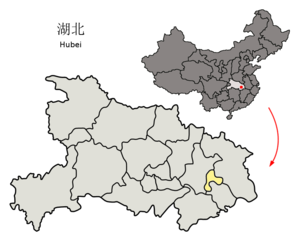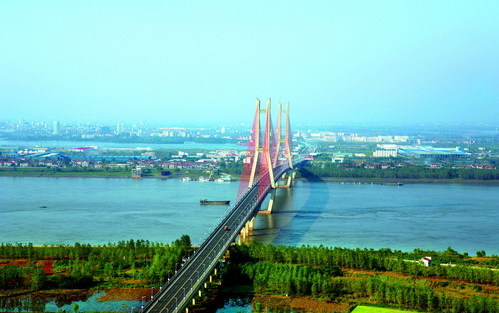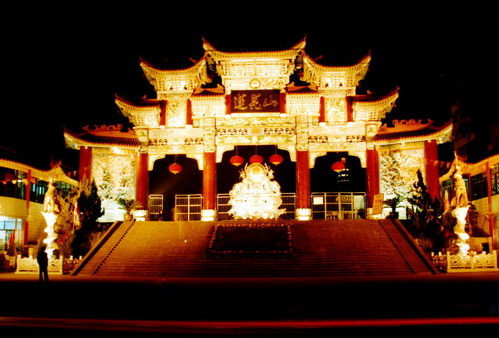| About Hubei | Culture & Arts | ||
| Attractions | Routes | ||
| Dining | Shopping | ||
| Hotels | Transportation | ||
| Entertainment | Travel agencies |
Jingshan to attract Wuhan tourists
Storytelling queen
For the love of Wuhan
Dangyang to promote tourism


Ezhou
(travelchinaguide.com, chinatravel.com, wikipedia)
Updated: 2011-11-21
 |
|
Ezhou is one of the most important port cities in the middle reaches of the Yangtze River. (photo from nipic.com) |

Ezhou, which covers an area of 1.504 square kilometers with a population of 1.05 million, is one of the most important port cities in the middle reaches of the Yangtze River, and also famous as the hometown of blunt-snout bream and archaic bronze mirror. The city lies in the east of Hubei province, bordered by Wuhan in the west and Huangshi in the east.
Long time before the Eastern Zhou Dynasty, this region has been called 'E' as a shire or a county. During the Three Kingdoms Period, the Wu Kingdom put it as the capital, and changed its name to Wuchang.
The terrain in southeastern Ezhou is higher and that in central and northwestern Ezhou is relatively flatter and lower. River and lake plains are mainly distributed in the west. The Yangtze River runs through the northern boundary area. The city has more than eighty lakes of all sizes.
Ezhou enjoys a subtropical monsoon climate, with an annual average temperature of 17℃ (63℉). It has abundant rainfall and sunshine, together with four distinct seasons. Summer is the rainy season, and the weather is torrid and wet. Spring and winter is cold.
 |
| Yangtze River bridge (photo from nipic.com) |
As a tourist city close to the Yangtze River, Ezhou is the one of great beauty, combining mountains, rivers and city as an integral whole. It has the natural scenery of landscapes based on Xishan Mountain, Liangzi Lake and Yanglan Lake; the attractions of historic sites including Yitingming Precipice, King Wu’s City, Guanyin (Goddess of Mercy) Pavilion; the humanistic sights represented by some historical celebrities like Sun Quan, Yuan Jie and Su Shi; and Buddhism attractions symbolized by Gulingquan Temple which is the birthplace of “ Pure Land Sect ” in Buddhism as well as the birthplace of the famous hometown of archaic bronze mirror all over the country. All of these have made Ezhou an important city along the “Three Kingdoms Period tourist Line” and "Yangtze Tourist Zone”, and one of the very important part of Chu Culture Tourist Area of Hubei province as well.
 |
| Entrance of the Lotus Mountain (photo from nipic.com) |
Ezhou is one of the birthplaces of Chu culture. As the former capital of King Wu in the Three Kingdoms Period (220–280), Ezhou has quite a lot of historic sites, with various humanistic cultures gathered together. Sun Quan left many historic cultural sites for posterity, including the relics of King Wu’s City, the relics of Haotang, the one of King Wu’s Reading Room, King Wu’s Summer Palace, King Wu’s Throne-ascending Forum, Jiuqu Pavilion, Guangyan Building, Sword-testing Stone, Sanhua Beach, Fishing Terrace , Fankou, King Wu’s Troops Station, Drill Ground, etc. At the same time, there are a large number of cultural and artistic works, poetry, paintings, and popular legend represented by "Romance of the Three Kingdoms” (name of a classic novel) which added strong flavor of Three Kingdoms and Wu cultures to the city. In addition, the historical figures represented by Sun Quan, Ge Hong, Yuan Jie, Li Yangbing, Su Shi and Huang Tingjian, as well as Ezhou Cultural relics preserved in Xishan Mountain, Liangzi Lake, Yanglan Lake, Zhaoshan Hill have both made our city the one of typical Three Kingdoms culture and Wu culture in our country.
 |
| Wanbaohai in the Lotus Mountain (photo from nipic.com) |
When to Go:
Ezhou is especially favorable for visiting at the summer's end and the start of autumn.
Tourist Tips:
Ezhou do not have airport. But Ezhou is only 50 kilometers from the capital city of the province, Wuhan, and 70 kilometers from Wuhan Tianhe International Airport. Visitors can get to Ezhou from Wuhan within one hour. Notable is that, there are no direct airport buses between Wuhan airport and Ezhou. Visitors should get to downtown Wuhan first.